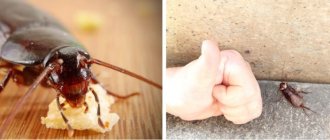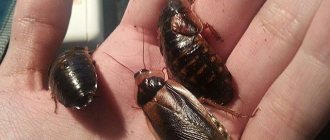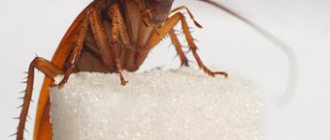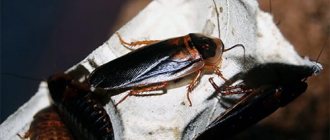The high fertility of cockroaches is one of the main reasons for their high survival rate. A distinctive feature of the species is that a female can mate with a male only once, and then produce offspring several times during her life. At the same time, cockroach eggs are more difficult to destroy than adult ones. They are protected by the ootheca, a membrane that is resistant to chemicals and other external factors. The death of all insects does not guarantee complete ridding of the house from parasites. If among them there were females with ooteca, then a few days after treatment of the room, nymphs may hatch from them. One solution to the problem is to re-apply the insecticide after 10-14 days. In the article, we will look at the difference between an egg and an egg, how many embryos one female produces in a lifetime, and also how to rid your home of annoying parasites.
Reproduction of cockroaches
A female cockroach only needs one mating, and throughout her life she lays fertilized eggs. An ootheca, a capsule containing eggs, is formed in her body.
Emergence of larvae from the ooteca.
The rate at which larvae hatch depends on several factors:
- the type of cockroaches themselves;
- ambient temperature;
- humidity level.
Where and how often are egg capsules laid?
In order to get rid of parasites forever, it is recommended to know where the eggs of red cockroaches are especially often located.
Since sufficiently comfortable conditions are necessary for the development of masonry, cockroaches often lay masonry in such secluded corners of the apartment as: the joints of wallpaper, the space under them, as well as tiles, cracks between floorboards, ventilation holes, the space under the bathroom, kitchen furniture.
In order to prevent the spread of insects, it is recommended to thoroughly vacuum the places where a cockroach can lay eggs; this measure, as well as maintaining cleanliness of the home, will help to eliminate the appearance of parasite colonies as much as possible.
What is ootheca
Ootheca of the cockroach.
This capsule is sealed, cocoon-like and acts as an incubator. It is a way of protecting offspring and a source of nutrition. The embryos mature in favorable conditions for up to two months. The eggs mature there first, but larvae can also grow immediately.
Most often, the shape of the oviposition is straight, slightly elongated. But there are round or even comma-shaped curved oothecae. They are small in size and very difficult to notice.
The eggs inside can be laid out in one or more rows. Their exact number depends on the type of parasite.
How do cockroaches reproduce?
2015-08-10 City Disinfection Station
Cockroaches are one of the most rapidly reproducing domestic parasites. As soon as one pregnant female gets into the house, the emergence of a huge population becomes inevitable. If the parasites feel comfortable in a new place, they find something to eat and drink, the cockroaches multiply at an incredible speed. You can understand that a cockroach ran past you, and not some other parasite, by its appearance. They look like this:
- Flat, elongated, oval-shaped body.
- Flat, triangular head.
- Gnawing mouth opening, turned downwards.
- Mostly black or red in color.
Types of cockroaches
There are two types of cockroaches you can find at home:
- Big black ones.
- Red (Prussians).
Black cockroaches reach 2.5-3 centimeters in length. Of the parasites found at home, they are the largest. Most often they live and breed in kitchens, which is why they are sometimes called kitchen bugs. But the most unpleasant are the Prussians: small red cockroaches that can crawl into any crack. They are about half the size of black ones, but this is their main advantage. Due to the size of the larger population of red cockroaches, less space is needed. There can be twice as many red cockroaches.
Cockroach breeding cycle
Cockroaches reproduce sexually, just like any other living creature. The reproductive process begins with mating games, after which the male and female mate. After one mating session, the female will be able to become fertilized several more times without a male.
The process of reproduction and development of small cockroaches is as follows:
- Females lay eggs in special leathery sacs called oothecae. Red and black cockroaches carry eggs with them, while other individuals prefer to hide them in secluded places.
- Formed embryos hatch from the leathery sacs 2-3 weeks after laying.
- The larvae develop and molt several times. These larvae are called nymphs and look like miniature adults.
- Large adults called adults are formed.
In one egg, a female black cockroach carries 10-20 larvae, and a female red cockroach carries 20-30. At one time, a female can give birth to up to forty new embryos. As much as will be enough to develop a population that will soon fill your apartment.
Features of reproduction
Over the course of her life, a female cockroach can lay 4-6 capsules before she dies. The female does not have to mate every time for this; the male’s gametes remain in her body. Cockroaches settle in colonies; newborns live together with adults. Small embryos are cared for by several females, who help them adapt and learn to survive.
Cockroaches do not have specific seasons in which they breed. The process is observed all year round, which can make the fight against them more difficult. If you miss the moment when they first appear at your home, the population will quickly grow. It will be necessary to fight them by radical means from the very beginning.
Life cycle of cockroaches
When fighting them, you need to know how long they live and how long they can last without food. The lifespan of one cockroach depends on whether there is food and food for it. At home, they live longer and reproduce more actively if they have access to food and water. Human houses are reliably sheltered from their external influences. They are not affected by temperature influences and are not hunted by birds and snakes. Possessing high adaptive properties, cockroaches move into homes.
The lifespan of a cockroach can range from four months to four years. They spend most of their life in the imago stage. The larvae grow quickly, large individuals appear in about 1.5 months. The development of the larvae may slow down in the egg if the living conditions of the cockroaches are poor. In good ones, on the contrary, they develop very quickly. Very soon the new adults will be ready to mate and will reproduce rapidly.
Without food and water, cockroaches cannot live long. Endurance depends on the type:
- redheads go without food and water for up to 30 days;
- black kitchen ones - up to 70.
Finding themselves without food, large cockroaches begin to devour smaller ones and also bite people. For example, they may bite the skin around their nails or lips. The survival rate of cockroaches is so high that they can even live without a head: they will breathe through holes in the body. They adapt to many poisons in just a few generations.
The cockroach population increases quickly in good conditions. If you notice one, you'll notice several more. Don’t let the parasite population get worse, start fighting right away. Moreover, cockroaches will move from your house to your neighbors' apartments. Not only your apartment, but the entire floor will be infected. It is also useless to fight them with simple means: they will simply run from place to place. Therefore, you can order specialists to treat your apartment against cockroaches - this will be the best way to fight it.
Submit a request to exterminate cockroaches
Cockroach eggs
Eggs in the ooteca.
Cockroach eggs are white or yellowish-white, 1 mm in diameter, densely packed in the ootheca in one or several rows. One such capsule contains up to 50 eggs; during her life, the female is capable of laying up to 8 oothecae. But large species, such as sewers, lay up to 20 times per life cycle. The shell of this capsule protects the offspring from external factors and is resistant to chemicals.
Some types of cockroaches deposit ootheca in hard-to-reach places, thus protecting them not only from people, but also from hungry members of their kind.
How many cockroaches will hatch from one egg?
In 30-75 days, a larva forms from the egg. The duration is determined by external factors. Optimal conditions for rapid development are high humidity and a temperature of about +30 °C. In a less favorable microclimate, the maturation of the nymph slows down, but does not stop. The embryos grow by absorbing nutrients. If the ootheca compartment becomes crowded, they gnaw through the membrane and come out.
If we talk about how many cockroaches will hatch from one egg, then it would be correct to say that there is only one. But this question in most cases refers to the number of embryos in one protective capsule.
Nymphs of red cockroaches are located in the lower and upper parts of the ooteca, 15-24 pieces each. Thus, from 30 to 48 larvae hatch from one egg. The American, Oriental and other larger species produce fewer offspring: a maximum of 16 nymphs hatch from one egg.
At the final stage of development, the nymphs independently open the egg shell and scatter in search of food and a secluded place.
Features of species behavior
In different species of cockroaches, laying can occur in different ways.
Madagascar
In the Madagascar cockroach, the female carries it inside herself, the larvae appear, pierce the shell of the egg, and come out on their own. Then their independent life begins as adults. They are considered viviparous.
Redheads
Red cockroaches usually breed in residential areas; females take good care of their offspring. They endure the oedema until the nymphs appear, and after that they take care of the babies for 2 weeks until they get stronger.
Black
Black cockroaches do not care at all about procreation. Females lay capsules with eggs right on the move, without particularly selecting places. That is why this species is considered one of those whose numbers are declining.
What do eggs and egg capsules look like?
Quite often, ordinary people confuse cockroach eggs with dense capsules called oothecae. This specific dense shell, the chemical composition of which is somewhat similar to the shell of bird eggs, contains masonry inside.
The capsule with cockroach eggs reliably protects them from the effects of negative environmental conditions, while the embryos receive the air necessary for growth and formation.
Depending on the subspecies of the insect, the ootheca may contain a different number of eggs. For example, the capsule of the most common red Prussian can hold up to fifty units.
It develops in the abdominal cavity of the female, which lasts for a certain period, the duration of which depends on the presence or absence of favorable conditions, and can range from a month to three.
When the eggs mature, the female looks for a suitable place for her offspring, after which she leaves the ootheca in a secluded corner. How many days do cockroaches hatch from eggs? If the ootheca is surrounded by favorable conditions, this hatching occurs after three to four weeks.
In the absence of sufficient heat, the maturation of eggs slows down; the brood may appear in two to three months.
The eggs themselves, enclosed in the ootheca shell, are microscopic - no more than a millimeter in size, white in color, and transparent. It is important to know what a cockroach larva, ootheca, and parasite eggs look like. This will help identify masonry and prevent the spread of pests.
How to destroy eggs
The number of eggs directly depends on the number of cockroaches. If there are many adult individuals, then they will accordingly deposit a large number of oothecae in the room. Females hide their clutches in secluded places:
- under baseboards;
- in a crack in the floor;
- under peeling wallpaper;
- under the bath;
- places in the kitchen behind the furniture;
- ventilation holes.
Finding places with masonry in the room is not easy. Eggs in the ooteca are reliably protected from water, pathogenic bacteria, chemicals and can withstand frost down to -11 degrees. This means, first of all, you need to get rid of females with oedema. To do this, disinfestation of the premises is carried out in order to destroy adult individuals. But the females could have time to lay an ootheca and after a few days the cockroaches could appear again. Re-processing will be required.
Several successful methods of controlling cockroaches and their larvae:
- Adults and larvae die if the air temperature drops below -3 degrees. The room with insects is frozen, such natural disinfestation is carried out in winter. Leave windows and doors open for a day, and the insects die at temperatures below -3 degrees. If there are a large number of cockroaches, in some cases repeated treatment may be necessary.
Have you encountered cockroaches in your home?Not really
- Chemicals are an effective means of controlling cockroaches. The industry produces a wide variety of available products: traps, crayons, gels, baits and other products. Each of them affects larvae and adults.
- Traditional methods are more suitable for preventive purposes. To repel cockroaches, decoctions and infusions of herbs and aromatic oils are used. However, using them for a long time, you can be sure that even young individuals that have just appeared will leave their home.
- If you can cope with cockroaches on your own, then you need to turn to professionals who have effective means, methods and professional equipment in their arsenal to combat these harmful insects.
How many eggs does a cockroach lay?
The high productivity of Prussians is the key to their rapid reproduction and good survival. How many eggs does a cockroach lay? Throughout her life, the female forms 4-8 clutches. The number of larvae in each of them can reach 48 pieces. This is a lot, even when compared with other pests and parasites. The number of eggs depends on the species of cockroach.
For laying, the female cockroach chooses the most secluded and inaccessible places for humans - cracks and holes in the floor, spaces under the baseboard and peeled wallpaper, ventilation holes, invisible voids under the bathtub and sink.
How to prevent mass reproduction
Chemical treatment is perhaps the most reliable and fastest way to get rid of these pests in the house. In this case, the insects die almost immediately, but this does not in any way affect the larvae, which at this moment are still in the ooteca. After some time, they will quietly hatch, and the problem with cockroaches will arise again.
To avoid this, after the first disinfestation, this activity should be repeated after 2 or 3 weeks in order to “finish off” the hatched young.
In addition, it is important to maintain cleanliness in the house: do not leave food open, take out the garbage on time, monitor the humidity in the apartment, and then the chances of unwanted neighbors will become much less.
Cockroaches can release gases, and after death they continue to release gases for another 18 hours, so cockroaches can be called the stinkiest insects in the world, and not bedbugs, as many believe.
Possible locations of the ootheca
The presence of cockroaches in apartment buildings has remained a problem for many years. These insects have become so adapted to human habitation that they successfully find safe places to breed:
- in ventilation compartments;
- in the cracks behind the baseboard;
- in the cracks present between parts of furniture;
- under washbasins, sinks, cabinets, beds;
- in utility rooms and storage rooms.
When cleaning an apartment, you come across dry shells of insect capsules. They must be taken out of the apartment to the trash can. If an ootheca of cockroaches is found, then it must be destroyed - there is a risk of the birth of a large number of pests.
Fighting cockroach populations on your own is a thankless task, because it is ineffective. The best way to get rid of it is to call a pest control service.
How to get rid of cockroach larvae
When there are a lot of cockroach larvae in an apartment, they begin to hide in places where adults cannot penetrate. This means that the young animals will quickly colonize household appliances, dishes, and even the slightest cracks and crevices. You need to get rid of cockroach larvae as quickly as possible. Moreover, the fight against nymphs is slightly different from the destruction of adult cockroaches.
There is scientific evidence indicating that resistance is more common among larvae, but irritability (the ability to avoid treated surfaces until a lethal dose is received, in other words, to sit out) is more common in adults. Resistance, that is, acquired resistance to insecticidal drugs, in larvae is usually hereditary, i.e. produced at the genetic level and passed on from generation to generation. And in everyday conditions it is impossible to determine what type of chemical substances the nymphs have developed resistance to.
How to effectively deal with cockroach larvae? To combat nymphs, it is recommended to use drugs from a special group - growth regulators (ASIs or chitin synthesis inhibitors). This is especially worth doing if cockroaches have resistance to the main classes of insecticides - FOS, pyrethroids and others.
Chitin synthesis inhibitors are chemical substances that inhibit the growth and development of cockroaches and prevent nymphs from molting. Chitin synthesis inhibitors work by preventing the formation of chitin, which is necessary for the formation of the insect's exoskeleton. Inhibitors prevent the correct formation of the new exoskeleton, resulting in the death of the insect. ISH can also kill eggs, disrupting normal embryonic development.
Death from chitin synthesis inhibitor products usually occurs within 10 days or more, depending on the product, the life stage of the insect at the time the product was applied, and its rate of development. The active ingredients of this class of drugs are included in some gel baits, such as Legion, Insectogel.
Before using the preparations, it is necessary to clean the area and limit the larvae’s access to food and water. Insectogel is applied dropwise to avoid stains on film or paper, at a distance of no more than half a meter from each other. The legion is drawn with dotted lines of two centimeters. The habitats, accumulations and movements of insects are subject to treatment. The gel is not used simultaneously with other contact insecticides.
Repeated treatment is recommended after 2-3 months. During this time, one can notice the morphogenetic effect of the substance, the appearance of larvae with various anomalies, dark-colored individuals, empty ootheca.
Maintaining cleanliness and order in the premises, absence of high humidity, proper storage of food and timely disposal of waste will help prevent the reappearance of cockroaches.
Features of the appearance of larvae
Quite interesting is the fact that some pests demonstrate a certain maternal instinct towards their offspring.
When cockroaches hatch from the eggs of a Madagascan representative, they crawl under the mother’s abdomen and remain under her direct protection for some time. The female hisses and makes threatening lunges when potential danger approaches. However, such care is only enough for 1 day. Classic Prussians practically do not care for their young. The offspring simply stays near the female for a few more hours, after which they scatter to secluded corners.
One of the interesting exceptions remains the species of relict cockroaches. In their case, after the “birth” of young individuals, they are looked after and provided with food. Upon reaching a certain degree of maturity, new members of society take their assigned place in the hierarchy of the colony. In this case, it is somewhat reminiscent of a termite mound with different ranks and its own complex hierarchy.
The process of “birth” of cockroaches
If how cockroaches hatch from an egg remains less clear, then the question of the timing of this process remains open. The fact is that a lot depends on environmental conditions. Thus, a new generation of insects is born most quickly at high temperatures (+30 o C) and humidity levels. At the same time, when the temperature regime changes to +15 o C and below, a slowdown in metabolic processes is observed, and the “birth” of offspring is postponed.
For those who don't know how long it takes for cockroach eggs to hatch, the average answer is 30-75 days. It all depends on the specific type of insect and the conditions in which small individuals develop.
It is also important to know that absolutely all types of pests lay eggs. Sometimes when observing a female Madagascar cockroach, you may mistakenly think that she is literally “giving birth” to her young as they emerge from her abdomen. However, it is not. The female simply lays eggs and stores them in a soft ootheca inside her body. When they hatch, the abdomen opens and new individuals emerge.
When “born,” the larvae are small in size (several millimeters) and have an almost transparent outer shell. Over time, chitin forms on the surface of their body, which darkens and gives the insects the corresponding color.
Why do cockroaches need eggs and an additional capsule (ootheca)?
The eggs of individuals are located compactly in the female’s body itself, and the shell, the ootheca, serves as the “packaging material”. It is distinguished by its ability to quickly harden in open air and acts as a protective capsule for the offspring of insects.
The word “ootheca” itself comes from the Greek language “oo” - egg and “tekos” - storage. Thanks to this additional shell, parasite eggs remain unharmed even in the most unfavorable conditions. It is the ootheca that allows you to preserve and maintain the population of cockroaches, because it protects the offspring from an aggressive environment, both in residential and confined spaces, and in nature.
On a note
Ootheca is present not only in cockroaches, but also in some invertebrate creatures. These include mollusks and mantises.
Depending on the type of cockroach, the ootheca may differ in appearance (shade, size, shape). This capsule has characteristic features:
- in black cockroaches it is a rich or dark brown color, the length is 1.2 cm and the width is 6 mm. At the top you can notice a specific bulge;
- in Madagascar cockroaches it is very long, can reach 25 mm, and it is about 4 mm wide.
The ootheca can be compared to the shell of an egg, since it also allows the embryos to be supplied with oxygen.
The number of eggs in an egg capsule varies. For example, in a red cockroach, the female carries approximately 20-30 eggs on her stomach in the ooteca; very rarely this number reaches fifty. All eggs are ordered, evenly arranged in 4 rows, tightly adjacent to each other.
The length of insect eggs is 1 mm; they have a white, yellowish shell, sometimes almost transparent. When magnified, a developing embryo is visible inside.
The ootheca forms gradually when the female begins to lay eggs. They are covered with a special sticky liquid at the moment they emerge from a special organ of the individual. However, upon completion of hatching, this secretion does not cease to be released, since it is required that the ootheca be clogged from the inside. At this time, the capsule is already clearly visible on the surface of the body and protrudes beyond its boundaries, but the female continues to wear it on her abdomen.
The eggs remain in the ooteca for 30-75 days. The higher the ambient temperature (more than 30°C) in the place where the female is located, and the more humid the air, the faster the growth of the offspring. If the temperature drops below 15°C, the growth of the larvae stops. The process starts again as soon as it gets warm. Thus, insects have adapted to the cold.
Interesting fact
Adult cockroaches are able to exist at temperatures from -5°C to +45°C; if these values are exceeded, the insects quickly die. However, the ootheca allows the offspring to remain viable during short-term cooling to -10°C and when the temperature rises to +55°C. Another feature is the capsule’s low exposure to chemicals used to control cockroaches. Some types of insects, for example, Prussians, carry swelling on their abdomen until the offspring appear. If under some circumstances the female dies, the larvae still continue to develop.
Some cockroaches tend to care for the eggs and try to protect the capsule.
So, black cockroaches get rid of the ootheca about 3-4 days after it has finally formed and is covered on all sides with an adhesive secretion. Then for 2 months it remains in the place where it was dropped by the insect. This leaves the capsule completely unprotected and at risk of being destroyed by parasites or predators. As for red cockroaches, when they find the eggs of their black counterparts, they simply eat them. As a result, the number of the species has been declining for a long time.
It is noteworthy that Prussians, as well as Madagascar and Ash cockroaches, take care of their brood. Thus, the female red cockroaches spend a certain period with oedema on the abdomen (until the larvae hatch), which makes it possible to select the most suitable conditions for the development of the offspring and protect them from danger.
In Madagascans, the ootheca is located in the body cavity; periodically the adult pushes it out to provide the eggs with an influx of oxygen. However, the process of emergence of larvae in these insects is even more complicated than in Prussians. Small cockroaches hatch right in the female's stomach, and then crawl out of the chamber.
Some people, when observing the birth of insects, get the impression that the female gives birth to offspring like mammals. But in reality everything is different: all larvae emerge exclusively from eggs hidden in the ooteca and in the abdomen of the parasite.
Another difference between different species is the number of peculiar “pregnancies” and egg capsules formed by female insects during life. A female Prussian is capable of producing no more than 9 ootheca, which contain a total of about 250 larvae. However, the vast majority of females can form only 3-4 ootheca.
In Prussians, the ootheca usually protrudes beyond the boundaries of the body, so it is immediately clear that the insect is preparing for reproduction. In tropical cockroaches, ootheca is not so noticeable.
How are cockroaches born?
Egg development lasts from one to two and a half months, provided there is sufficient humidity and suitable temperature. The optimal temperature for the development of embryos is +30° C. If the temperature is below +15° C, development is inhibited and resumes only when it gets warmer. Thanks to this adaptation, the embryos do not die during cooling, which generally contributes to the preservation of the Blattella germanica species.
The egg capsule turns out to be more resistant to extreme temperatures than the adult insect itself. Thus, for a Prussian, the endurance limits range from -5° C to +45° C. Above and below these temperature values, the cockroach dies. And the ootheca can withstand short-term exposure to more extreme temperatures: heating up to +55° C and lowering the temperature to -10° C.
The walls of the “storage” save the offspring from poisons. The female herself may die from exposure to an aggressive chemical compound, and the larvae in the capsule develop further.
It is common for Prussians to take care of their offspring. The female carries the capsule with her and, in moments of danger, simply runs away with it. Unlike Prussians, blacks do not have similar parental feelings. On the fourth day after the final formation of the “storage”, the female leaves her future children and they become easy prey for various predators, including Prussians.
In the Madagascan species, the “storage” is located inside the female. She ventilates it several times a day, exposing it to fresh air, which is necessary for embryos to breathe. There, larvae begin to be born inside the female. The moment of their appearance is similar to a live birth, although it is not.
Embryos feed on organic substances that come to them from the embryonic fluid that surrounds them . Nutrition leads to their growth. When they no longer have enough space, the embryos tear the walls of the egg and capsule.
Differences between the sexes
Adults vary depending on their gender. The sex of an insect can be determined by the following distinctive features:
- Size.
Males are smaller than females; - Leads.
Male cockroaches have a genital plate, which is a growth on the last segment of the body; - Wings.
In males they are more developed - males can even fly up to get to the desired object.
The wings of females serve solely for decoration - with their help, female cockroaches show their readiness to mate.
Pest Control
Having considered all the intricacies of the maturation and development of these unpleasant insects, we can determine the rules for combating them. To minimize the risks of the formation and reproduction of colonies, it is necessary to narrow the number of potential areas where cockroaches live. The ideal option would be to renovate the apartment - fill holes in the floor and seal cracks in the walls, re-glue the wallpaper, cover the ventilation compartments with a fine mesh.
You need to watch the bread crumbs very carefully. The slightest amount of them in a room will provide energy to an insect colony for almost a month. It’s not worth mentioning about the accumulation of garbage in the apartment. It is important to isolate pests from access to water, and it is better to protect yourself from guests from neighbors with special poisonous traps.
Ventilation of rooms is necessary daily. But in winter, sub-zero temperatures are detrimental to eggs. Hot steam treatment helps, but this can only be done by specialists. You should also remember that one-time cleaning of the room will not give results - several treatments are required.
How long does it take for a cockroach to grow?
A newly hatched cockroach looks like a small white bug. The shell will not be white for long. As it hardens, it will darken and more and more resemble the color of an adult insect. But despite this, in the first few weeks it is not easy to recognize a cockroach in a small, fussy insect. The larva will resemble an adult in appearance only 3-4 weeks after birth.
The development of a red cockroach at the larval stage can take from several weeks to six months. These terms are quite arbitrary, since how quickly cockroaches grow is largely determined by external conditions, in particular the availability of water and food, the size of the colony, and the temperature in the room.
As for cockroaches of other species, a year or even more may pass from the moment the nymph appears until it reaches the adult stage. All this time, the size of the insects increases, but the adults no longer grow.
Are there viviparous cockroaches?
Cockroaches are not viviparous creatures. The terms “ovoviviparous” and “oviparous” are used for these insects.
If the embryo develops in an egg and does not receive nutrition from the mother’s body during development, but is still in the female’s body, then this method of reproduction is called ovoviviparity.
Those cockroaches whose females simply leave their ootheca to the mercy of fate are typical oviparous insects. The same species in which the eggs develop inside the female’s body, and the nymphs hatch simultaneously with their exit from the brood chamber, are ovoviviparous.
Therefore, the terms “pregnant cockroach” and “viviparous cockroaches” are not entirely correct - only viviparous animals are truly pregnant.
From a scientific point of view, the expression “cockroaches give birth” is not entirely correct. This process is not called childbirth, but birth.
In the photo there is a female Madagascar cockroach with nymphs emerging from her abdomen:
Where do females hide their eggs?
In order to effectively combat pests, a person should know where, most likely, the female will leave her clutch. She mainly chooses secluded, inaccessible places where her offspring will not be disturbed.
These are:
- Gaps between furniture.
- The space under the bedside tables.
- Along or behind baseboards.
- In the ventilation ducts.
- On shelves in the pantry.
- Under the sink.
Knowing the location of the eggs, you can better fight cockroaches. If even a hint of unwanted guests appears, it is worth taking measures to eliminate them. Fortunately, at the moment there are quite a lot of different ways to destroy this type of insect.
And this is what the process of “birthing” cockroaches into the world looks like:











